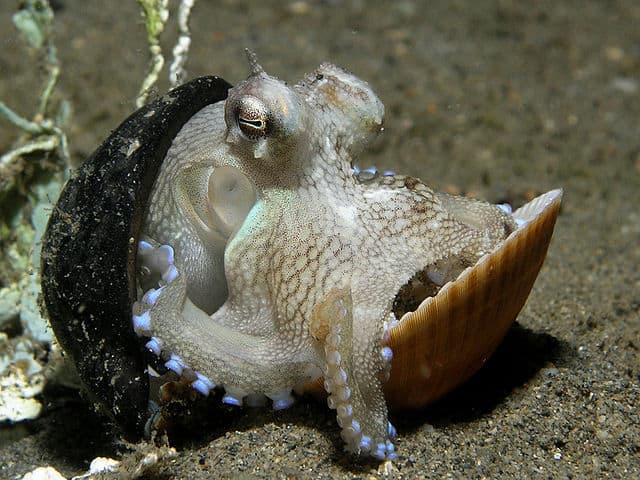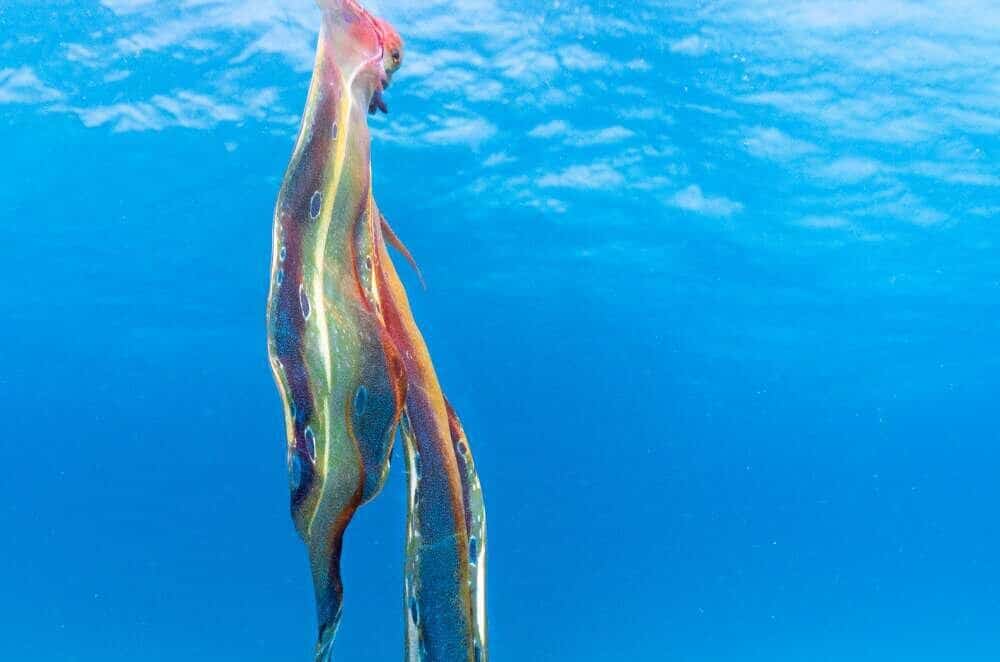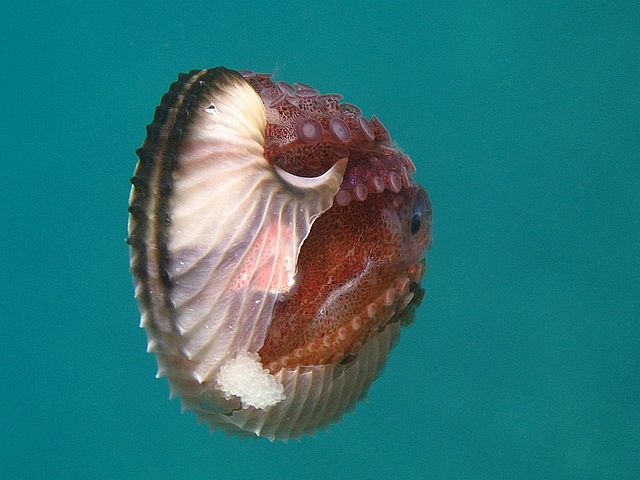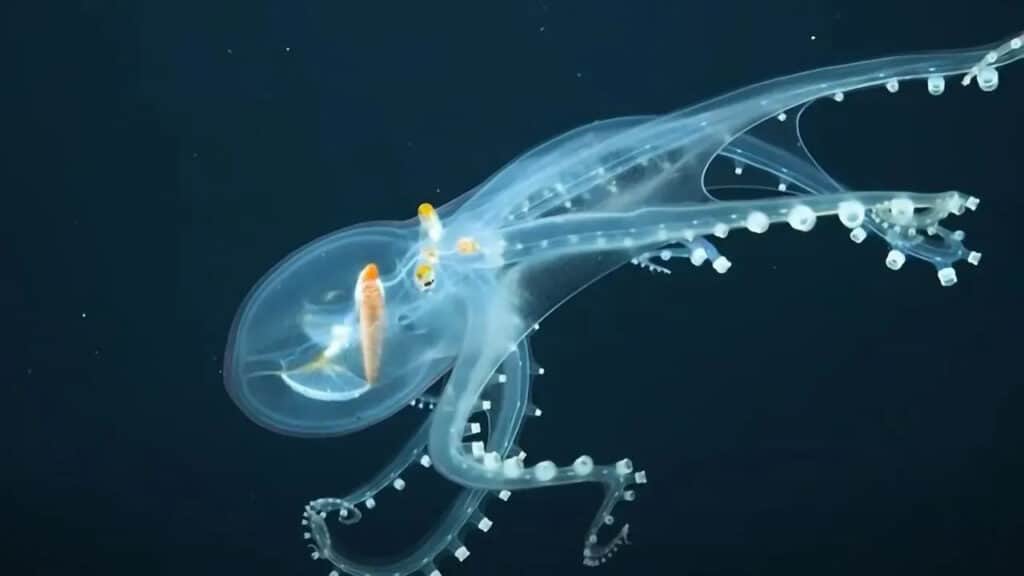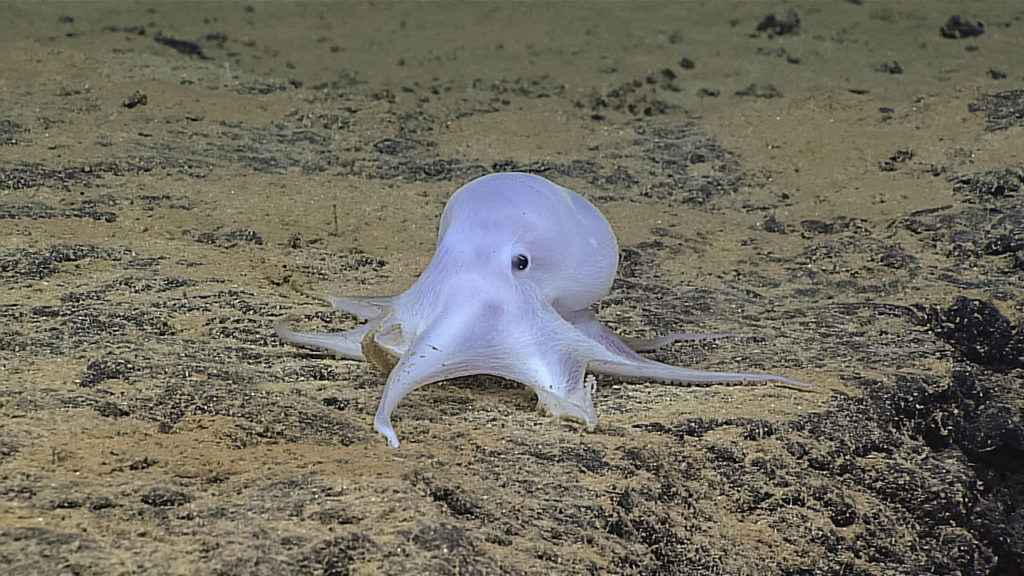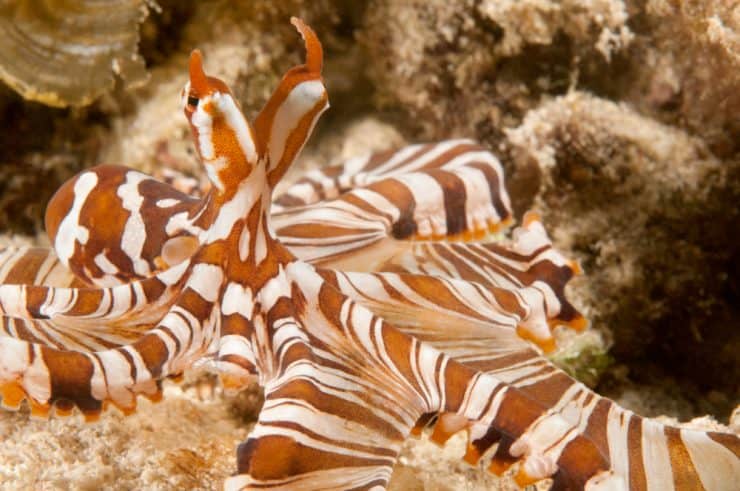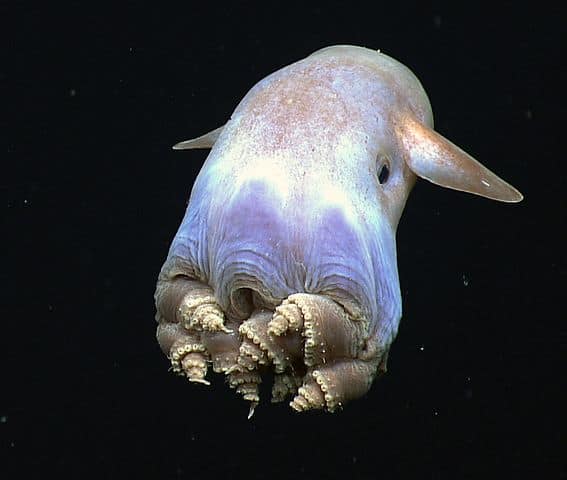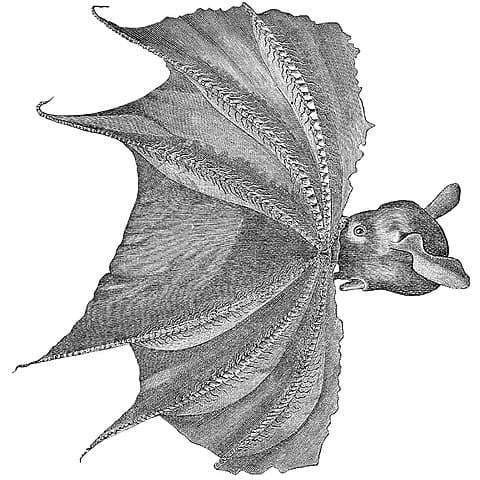Octopuses are known to be the most intelligent species among all invertebrates. They are excellent at camouflaging and mimicking. They have a super-flexible body that helps them radically alter their shape. They come in diverse shapes, sizes, and colors and have a highly complex nervous system and exceptional eyesight.
There are about 300 known species of octopus around the world. Some species are quite common and can easily be found, while some others are extremely rare and can only be spotted once in a while.
Here, we have gathered a list of 8 unique and rare types of octopus species.
8. Coconut Octopus
Scientific Name: Amphioctopus marginatus
Size: Around 6 inches
Found in: Western Pacific and Indian Ocean

photo source: wikipedia.org
The coconut octopus, also known as the Veined octopus, lives in the shallow coastal waters of the Indian Ocean and Western Pacific Ocean. They have a dark brown body with darker arms and white suckers.
They use the empty coconut shells as their home as well as defensive tools. They carry them along, holding them with their six arms while walking on only two arms. Their ability to move on two limbs makes them a unique octopus species. The only other octopus species that demonstrate similar ability is the Algae Octopus.
Did you know?
The arms of an octopus contain two-thirds of its neurons. As a result, the arms can function on their own without any input from the brain. Studies show that the arms of an octopus can react even after they are completely severed from the body.
7. Blanket Octopus
Scientific Name: Tremoctopus Violeceus
Size: Female grows up to 6.6 feet, and males are less than one inches
Found in: North and South Atlantic Ocean

photo source: cdn.net
The blanket octopus gets its name from the sheets of transparent webbing that connect the arms of a female blanket octopus. They create a blanket-like silhouette by stretching their arms when they feel threatened.
Blanket octopuses never rest on the seafloor; they are always in the open ocean. Blanket octopuses are best known for their sexual dimorphism. A mature female octopus grows as long as 6.6 feet, while the size of its male counterparts is less than one inch long. The weight ratio can reach up to 40,000:1. It is one of the highest size differences between the two sexes in the animal kingdom.
The male octopus has a detachable hectocotylus- a modified arm containing their sperms. While mating, the male octopus gives it to the female, and she keeps it in her mantle cavity.
Did you know?
Blanket octopus is immune to venomous jellyfish called the Portuguese man of war. The male and immature female blanket octopus rip off the tentacles of this dangerous jellyfish and use them in their defense.
6. Argonaut
Scientific Name: Argonauta spp
Size: Females grow up to 4 inches with shells up to 11 inches, and males grow up to 0.79 inches
Found in: Tropical and subtropical seas around the world

photo source: wikipedia.org
Argonaut is a rare octopus species that is considered wired and exceptional. They exhibit sexual dimorphism both in terms of size and lifespan, however, the size difference is not as extreme as the Blanket octopus. The female specimens of argonauts are eight times larger and 600 times heavier than their male counterparts.
Besides, male argonauts only get to mate once in their lifetime, whereas females reproduce many times over the years. The female species of argonaut is known from ancient times, but the males were first identified as late as the late 19th century.
Like the Blanket octopus, the male argonaut has a modified arm called hectocotylus that contains sperms. During mating, this arm is released and stays inside the female.
After this, the female octopus starts secreting calcite to form a delicate, papery shell. She lays her eggs inside the shell and then squeezes in.
Did you know?
Argonaut octopuses are also known as paper nautili. The name came from the paper-thin shell the females create for laying the eggs.
5. Glass Octopus
Scientific Name: Vitreledonella richardi
Size: Around 18 inches
Found in: Tropical and subtropical seas around the world

photo source: technologynetworks.com
Vitreledonella richardi, commonly known as Glass Octopus, usually lives in the deep waters, at around 3,000 feet or even deeper. Glass octopuses were first discovered in 1918. However, this elusive creature is rarely seen and thus one of the least studied cephalopods in the ocean.
Glass octopuses, as the name suggests, have an almost transparent body. Only their eyes, optic nerve, and digestive tract appear to be opaque. The length of an adult specimen is around 18 inches, and they have 4.3 inches long mantles.
Among the eight legs, two are smaller than the other three pairs. The longer legs are around 2-3 times the length of the mantles.
The life expectancy is not known; however, it is thought that they live around two to five years.
Did you know?
Like many other octopus species, the female Glass octopuses quit eating after laying the eggs, and by the time the eggs hatch, the mother dies. That means an adult female octopus reproduces only one in her lifetime.
4. Ghost Octopus
Scientific Name: NA
Size: Around 4.75 inches
Found in: Hawaiian archipelago

photo source: naturecanada.ca
Ghost octopus is a newly found species discovered only in 2016. In February 2016, a US rover called Deep Discoverer spotted an unfamiliar-looking octopus near the north of the Hawaiian Archipelago.
Scientists nicknamed it Casper due to its resemblance with the friendly cartoon ghost. The octopus was discovered swimming more than 14,000 feet deep. It makes it the deepest-dwelling octopod ever found.
The ghost octopus looks pale due to a lack of pigmentation. They have only a very few muscles in their body, and as a result, they get an almost gelatinous consistency. Scientists believe they get this consistency because building muscles requires a lot of energy, and food is scarce in the deep sea.
Did you know?
The female ghost octopus lays eggs on dead sponges. These sponges that are needed for their reproduction grow only on manganese nodules as they are often the only hard object found in the depths of the Pacific. Deep-sea mining endangers the existence of this species and makes them especially vulnerable.
3. Larger Pacific Striped Octopus
Scientific Name: NA
Size: Females are less than three inches, and males are smaller
Found in: Tropical water of Eastern Pacific

photo source: www.americanoceans.org
The larger Pacific Striped Octopus (LPSO) was first found by Panamanian biologist Aradio Rodaniche. His submission to the Bulletin of Marine Science in 1991 didn’t pass peer review as his fellow zoologists found the species to be too bizarre to be real.
After two decades, Californian scientists rediscovered the LPSO and displayed it in public in early 2013.
Octopuses are usually not social beings and do not form a community. However, it has been observed that LPSO forms groups of up to 40 individuals. Their mating and hunting behavior also significantly differ from other octopus species.
They have a unique combination of stripes and spots on their body. Usually, they have brown and white stripes on their heads and mantle and white dots on their arms. Some of them may also appear completely pale or dark brown.
Did you know?
Due to the aggressive nature of female octopuses, most octopus species maintain a distance while mating. However, the Larger Pacific Striped Octopus uses an intimate approach and joins their beaks to mate.
2. Dumbo Octopus
Scientific Name: Grimpoteuthis spp.
Size: 8-12 inches
Found in: North/South Pacific & Atlantic Oceans

photo source: wikipedia.org
It got its name from the 1941 Disney movie Dumbo. They have ear-like fins extended from the mantle. They move around by slowly flapping their fins.
Before the discovery of the Ghost octopus, Dumbo octopuses were thought to be the deepest-dwelling octopus. They live at least 13,100 below the surface in extremely cold water where sunlight doesn’t reach.
Did you know?
The usual size of an adult female Dumbo octopus is about one foot or slightly less than that. However, the largest one ever recorded was about 5 feet 10 inches long and weighed around 13 pounds.
1. Cirrothauma magna
Scientific Name: Cirrothauma magna
Size: Around 8 inches
Found in: South Indian Ocean between Prince Edward Island and the Crozets

photo source: wikipedia.org
Cirrothauma magna is the rarest octopus species on this list. Only four specimens of this rare octopus have ever been captured. Thus, available information on this species is fairly limited. It does not even have a common name.
An adult Cirrothauma magna has three types of suckers. The suckers nearest to its mouth are small and cylindrical with thick stout stalks and are separated by 1 cm. The following suckers have long stalks and small openings, and the gap between them is 2-3 cm. The distal suckers (sucker number 30+) are muscular with a bowl or barrel-shaped fleshy base.
They gradually increase in size.
Did you know?
The IUCN Red List of Threatened Species put Cirrothauma magna under the category of Data Deficient. The population size and trend for this species are still unknown to the scientists.

